Industry News, trenchless people
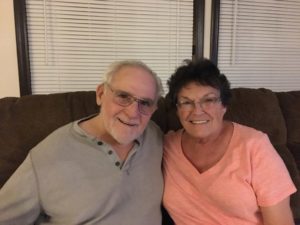 The trenchless industry lost a founding member with the recent passing on July 8 of James (Jim) Barbera at the age of 79. James Barbera founded Barbco Inc. in 1989. Today, the company leads the auger-boring industry with equipment that promotes safety and efficiency, such as the TriBor, Flexbor and Pathfinder.
The trenchless industry lost a founding member with the recent passing on July 8 of James (Jim) Barbera at the age of 79. James Barbera founded Barbco Inc. in 1989. Today, the company leads the auger-boring industry with equipment that promotes safety and efficiency, such as the TriBor, Flexbor and Pathfinder.
In November of last year, the Trenchless Technology Center (TTC) at Louisiana Tech University honored James and his brother Leo with lifetime achievement awards for their contributions to the trenchless industry. During the award celebration TTC also unveiled the Barbera Underground Infrastructure Research and Training (BUIRT) Facility. Named in honor of the Barbera family, this state-of-the-art facility will offer research, training and development for the trenchless technology industry.
Barbco has been a generous supporter of NASTT and the trenchless industry throughout the years and their involvement has been very important to us. We send our condolences to the Barbera Family and the team at Barbco.
Image: Jim Barbera and his wife Fran
trenchless people, trenchless projects
When a municipality puts out an RFQ for an engineering project and includes the following words—design a temporary sanitary sewer bypass system as needed to construct improvements—design engineers need to focus on two tasks: defining the scope and designing the solution. But typically, sewer bypass is just one part of a much larger project, and often design engineers aren’t trained in sewer bypass design. Fortunately, you can ask for help from bypass subcontractors and rental companies. That way, when your engineering firm helps the municipality take the project out for bid, estimators will be working with solid information that will help ensure reasonable bids.
The goal is to scope and design quickly, accurately, and effectively to avoid expensive mistakes and delays. Read on for a how-to guide to help you get it right.
Define the Scope
Before listing the steps to define the scope, let’s define what project scope actually means.
Projects are time-constrained undertakings to produce a product, service, or result. The scope defines the purpose, the ultimate goal, and how you will achieve it. Scope also determines the boundaries—what’s included in the project and what’s not. If you fail to define scope adequately, your project will likely end up over budget and behind schedule.
According to the Project Management Institute, scope changes are the single biggest reason projects fail. If the scope becomes a moving target, you’re increasing the chance for the project and your career to take a nosedive.
Here are six steps to help you thoroughly define the project scope.
- Provide an overall project description. The project description should include what the municipality wants to accomplish, the current sewer capacity, equipment in use, location and layout of existing facilities, and duration of the project. You may also want to note challenges, such as existing buildings, roads, and other structures, or areas of environmental concern such as creek crossings.
- Explain the driving forces. Billions of dollars in federal aid have been made available to rehabilitate decaying sewer systems. Many municipalities have taken advantage of the funds to initiate rehabilitation projects, whether for sewer lines, lift stations, or wastewater treatment plants. Or the municipality may be working under a consent decree that mandates specific improvements to a sewer system by a deadline.
- Specify the deliverables. The municipality’s requirements may list the details of sewer system improvements. But often the sewer bypass system itself simply directs you to design a system that will allow the improvements to be made without an interruption of service. It’s up to you to determine the requirements and provide the specifications.
- Determine the boundaries. Based on the improvements the municipality intends to make, you’ll need to determine exactly what the sanitary sewer bypass system should look like to meet the sewer requirements for as long as the project is active. For example, you’ll need to determine if the temporary system must operate at all times during construction, if it can be tied into the existing sanitary sewer system overnight, if the existing sanitary sewer system can be returned to normal flow for long periods, and if the flow can be partially diverted or must be fully diverted.
- State your assumptions. Define the conditions you’re assuming and their impact on the project. For example, the municipality may claim sandy soil in an area. If it’s actually rocky, you’ll be less productive while dealing with unexpected soil conditions. That will impact project time and cost, and generate a change order.
- List uncertainties and potential impacts. Uncertainties create risk and cost money. For example, you need to know up front of any time limitations on when work can be performed to complete the project. You also need to be aware of physical obstructions such as rivers and streams, railroad crossings, parks, and public and private property the sewer bypass may need to cross.
Design the Solution
Your bypass system design needs to be as detailed as possible, or you risk change orders, higher costs, and a damaged reputation. You may want to rely on a bypass subcontractor and/or rental company to help you specify accurately. In addition, technology continues to evolve, and the design should allow the project to meet the highest standards at the lowest cost in the shortest amount of time.
If you’ve established a partnership with a company with expertise in designing sewer bypass systems, you’re a step ahead. You can provide the known parameters to the bypass subcontractor or pump rental company and receive a sewer bypass design in return. For parameters that the municipality can’t provide, your partner can go on site and fill in missing pieces of engineering data to ensure the designed system will operate as intended. A bypass subcontractor will typically provide you with a quote up front, but you normally won’t receive the engineering submittal until after you sign a contract. The engineering submittal and drawings should show exactly how they’ll perform the project and what assumptions they’ve used to make calculations. You can take that back to the municipality for confirmation.
To keep your plans for a sewer bypass on point, here’s a list of the key requirements and where you can get the information to specify them.
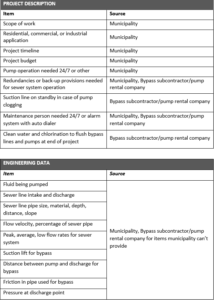
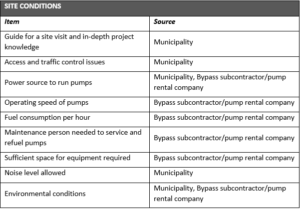
We hope this guide will help you better define the scope and design the solution for sewer bypass projects. But you don’t have to go it alone. It helps to work with a partner that can not only provide high-quality equipment and accessories, but engineering knowledge and installation expertise.
Interested in learning more? Join Sunbelt Rentals for a free webinar with Trenchless Technology on August 15, 2019 at 2 pm EST. Register here
Industry News, trenchless products
Project Profile:
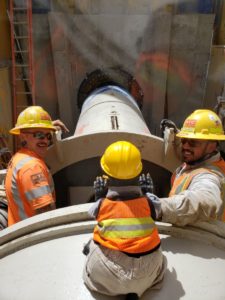 Salt Lake City Public Utilities is increasing capacity and upgrading a portion of their sanitary sewer collection system from 1500 S – 2700 W to Redwood Road. The project bid in January 2019 and Whitaker Construction was selected as the low bidder. BTrenchless Inc. was awarded the grade-critical tunneled crossing of I-215, a major interstate in Salt Lake City. The tunnel was designed as a 466LF long, 48″ diameter steel casing with a future 30″ HOBAS carrier pipe skid in it afterwards. BTrenchless decided to upsize the casing to 51″ diameter to match the dimensions of their Akkerman SL51 Microtunnel Boring Machine (MTBM). The center of the tunnel was about 7FT below the water table with extremely soft soil consisting of lean clay, fat clay, and silty sand. This type of ground water and soil condition suits itself well for a MTBM installation method.
Salt Lake City Public Utilities is increasing capacity and upgrading a portion of their sanitary sewer collection system from 1500 S – 2700 W to Redwood Road. The project bid in January 2019 and Whitaker Construction was selected as the low bidder. BTrenchless Inc. was awarded the grade-critical tunneled crossing of I-215, a major interstate in Salt Lake City. The tunnel was designed as a 466LF long, 48″ diameter steel casing with a future 30″ HOBAS carrier pipe skid in it afterwards. BTrenchless decided to upsize the casing to 51″ diameter to match the dimensions of their Akkerman SL51 Microtunnel Boring Machine (MTBM). The center of the tunnel was about 7FT below the water table with extremely soft soil consisting of lean clay, fat clay, and silty sand. This type of ground water and soil condition suits itself well for a MTBM installation method.
During design the team discovered an old as-built drawing of a now abandoned 12″ diameter concrete pipe in the path of the tunnel at approximately 320LF out. A series of GBM pilot tubes were installed ahead of the 51″ diameter tunnel launch in an attempt to proof the drive and find this pipe. Two of the
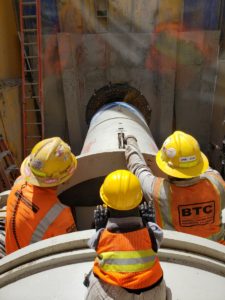
four pilot tube drives were deflected in this area; indicating that something was out there. After lots of internal discussions the decision was made to carry on with the original design and attempt to tunnel through this questionable area at 320LF out. While carefully tunneling through this area, a large pocket of river rock was discovered, but no remnants of any concrete pipe were ever found. This was great news for the project team. The end result was a successfully installed 51″ casing under I-215 for Salt Lake City Public Utilities, allowing Whitaker Construction to continue on with their project as planned.
Photos: Morty the Tunnel Rat and two members of the BTrenchless Crew getting ready for an Akkerman MTBM launch.
trenchless people
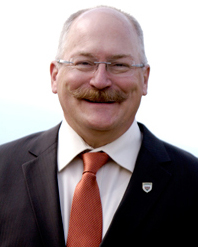 Scott Rosenthal, Associate Professor and Department Head of Mining Engineering at Montana Tech
Scott Rosenthal, Associate Professor and Department Head of Mining Engineering at Montana Tech
How long have you been involved with underground infrastructure and trenchless technology? What brought you to the industry and/or your specialty area?
In my career as a mining engineer I was never directly involved with trenchless technology applications. After becoming a professor of mining engineering, I had a graduate student look at a novel directional drilling concept for open pit mining and as part of that project we looked at existing trenchless technologies. Prior to this project, I had always been fascinated by tunnel boring machines (moles) from the mining side and what they have accomplished in civil infrastructure construction and mining applications. We are re-introducing an underground construction course for our students which will include an exposure to tunnel boring machines.
You’ve had a successful career in mining, both in the field and as an educator. What drew you to mining and eventually to teaching?
What drew me to mining was a fascination with minerals that my father, a ceramic engineer, instilled in me. Where do you find the best minerals? In mines. Once I began studying mining engineering, I realized the industry had the biggest and coolest machines around and I was hooked. It was always on my bucket list to teach and after doing several guest lectures at a couple of universities, an opening arose at my Alma Mater, so I applied and was selected to join the team.
Share one project/objective you and your students are working on or recently worked on.
Placement of our students is not always in mining engineering roles and a number of our graduates accept positions with heavy civil contractors. Adding a knowledge of trenchless technology to their education through our underground construction course will add another tool to their tool belt. The project I am working on is building the underground construction course with the aid of industry contacts and attending an industry sponsored education forum for university professors this summer.
Why did you join NASTT? Are you planning on attending No-Dig 2020?
I joined NASTT because it is the industry organization focused on trenchless technology. It will help me build the relationships I need to be successful in educating our students going forward. As the faculty advisor for our NASTT student chapter, my membership demonstrates to the students my commitment to supporting them, the profession and NASTT. I do plan on attending No-Dig 2020 and hope to be able to bring a few students along as well.
Any upcoming travel/vacation plans? Traveling with family, friends?
Sonya, my wife, and I are very involved with the Rocky Mountain Elk Foundation here in Montana. Our big summer get away is to the annual Rocky Mountain Elk Foundation’s Elk Camp in Park City, Utah. The rest of the summer is committed to enjoying the brief Montana summer and continuing work on an historic preservation project that we have.
Anything special you like to do when you’re not working?
Back to the love of minerals and mining—I do underground tours at the World Museum of Mining here in Butte to help out the museum and to help educate the visitors about the past and present importance of mining; and, occasionally I get out into the mountains to look for minerals and spend a little time panning for gold in a favorite creek.
Book you are reading? Construction Vibrations by Charles H. Dowding is my current reading of choice for two reasons: 1. back to the development of our underground construction course, this text helps quantify why trenchless technology has applications for large civil projects versus traditional underground drill and blast; and, 2. I am working on a PhD that may involve research around underground vibrations in adjacent openings from nearby blasting.
Sports team? Green Bay Packers
Android or iPhone? iPhone because a millennial once joked if I owned one, I couldn’t figure it out (he was wrong).
Favorite App? Any banking pp that allows me to deposit checks—what a time saver!
Interested in joining NASTT? Click here for more info or contact Carolyn Hook for details.
Industry News, trenchless people, trenchless products
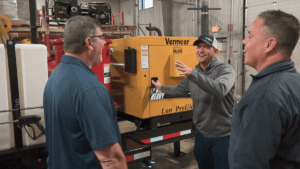 PELLA, Iowa, – With 24 locations throughout Michigan and Indiana, MacAllister Rentals, the region’s authorized CAT Rental Store, rents, sells, and services a wide range of high-quality equipment from Caterpillar and over 50 other manufacturers. As a part of the Indiana-based and family-owned MacAllister Machinery, MacAllister Rentals has an impeccable reputation for supplying contractors with first class service, in-depth technical knowledge, and top-notch equipment including the Vermeer Vac-Tron Series trailer vacs.
PELLA, Iowa, – With 24 locations throughout Michigan and Indiana, MacAllister Rentals, the region’s authorized CAT Rental Store, rents, sells, and services a wide range of high-quality equipment from Caterpillar and over 50 other manufacturers. As a part of the Indiana-based and family-owned MacAllister Machinery, MacAllister Rentals has an impeccable reputation for supplying contractors with first class service, in-depth technical knowledge, and top-notch equipment including the Vermeer Vac-Tron Series trailer vacs.
Project Challenge
The team at MacAllister Rental wanted to offer customers with an effective soft excavation method that would deliver outstanding productivity safely. They were familiar with vacuum excavators but wanted to find an equipment partner that manufactured quality machines that were easy to operate and efficient to run.
Solution
MacAllister Rental added Vac-Tron vacs to its fleet eight years ago. Since then, rental demand for these machines has increased significantly, and the rental store has continued to grow its fleet of Vac-Tron vacs. “We feel that CAT is the leader in the hydraulic excavator industry and the Vac-Tron series trailer vac is an industry leader in the vacuum excavator industry, so it fits very well with what we are trying to accomplish,” said Dan Hickman, district sales manager.
According to Chad Brogan, a sales representative with MacAllister Rental, most of their customers use Vac-Tron vacs for precise excavation when conventional excavation is not able to be used. “We have also found other uses for the Vac-Tron vacs with construction and foundation cleanup after heavy rains. It was a no brainer to add it to our fleet because we want to provide the best solutions for our customers,” he added.
Results
“Customers have commented that when they have these on their jobsites, they really have a vacuum, pressure washer, and an air compressor all built into one piece of equipment,” explained Hickman. “I can’t say it enough; contractors can be much more efficient using Vac-Tron vacs than other excavation methods when working around fiber optics, gas or water lines, as well as near foundations and wells. All that material gets sucked up into a self-contained unit, and they can dispose of it where they want to. Our customers get a cleaner jobsite, the job gets done faster with a lot fewer people, so it makes them money,” he concluded.
Learn more about Vac-Tron by visiting vactron.com.
 The trenchless industry lost a founding member with the recent passing on July 8 of James (Jim) Barbera at the age of 79. James Barbera founded Barbco Inc. in 1989. Today, the company leads the auger-boring industry with equipment that promotes safety and efficiency, such as the TriBor, Flexbor and Pathfinder.
The trenchless industry lost a founding member with the recent passing on July 8 of James (Jim) Barbera at the age of 79. James Barbera founded Barbco Inc. in 1989. Today, the company leads the auger-boring industry with equipment that promotes safety and efficiency, such as the TriBor, Flexbor and Pathfinder.





 PELLA, Iowa, – With 24 locations throughout Michigan and Indiana, MacAllister Rentals, the region’s authorized CAT Rental Store, rents, sells, and services a wide range of high-quality equipment from Caterpillar and over 50 other manufacturers. As a part of the Indiana-based and family-owned MacAllister Machinery, MacAllister Rentals has an impeccable reputation for supplying contractors with first class service, in-depth technical knowledge, and top-notch equipment including the
PELLA, Iowa, – With 24 locations throughout Michigan and Indiana, MacAllister Rentals, the region’s authorized CAT Rental Store, rents, sells, and services a wide range of high-quality equipment from Caterpillar and over 50 other manufacturers. As a part of the Indiana-based and family-owned MacAllister Machinery, MacAllister Rentals has an impeccable reputation for supplying contractors with first class service, in-depth technical knowledge, and top-notch equipment including the